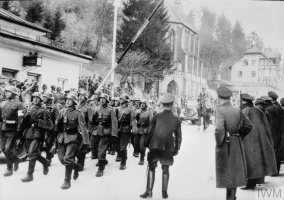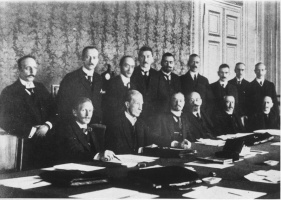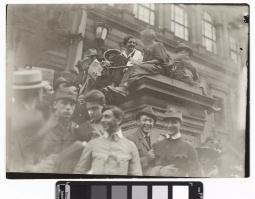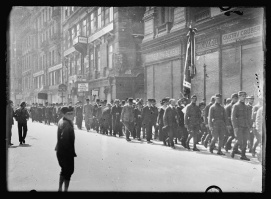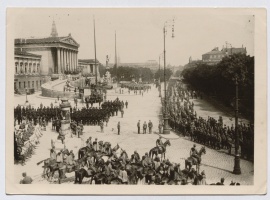Introduction↑
In some respects, World War I resembled a sort of a bloody “time out” for Austria, rather than a caesura. Continuity prevailed against the backdrop of a “long fin de siècle” from roughly 1870 to the 1930s; demographic patterns, social structures, mentalities and mindsets did not alter fundamentally. Many of the same influences and personalities, decision makers and opinion leaders coined ongoing scientific and artistic discourses, both before 1914 and after 1918. Gender relations, briefly altered as women entered the workforce during the war, did not change in the long run. When soldiers returned home and adopted their former positions, women were immediately replaced. Meanwhile, an imperial way of thinking survived, expressed in pro-Habsburg feelings and pan-German ideas. The interwar period led to the more conservative, traditionalistic and militaristic atmosphere of the 1930s, putting an end to the socialist “experiment of a Red Vienna”. Eventually, remnants of the turn of the century’s signature movements, such as the conflict of modernist and anti-modernist forces around 1900, including Jewish intellectual achievements as well as the upswing of anti-Semitism, were wiped out by the demolition of democracy, brutal National Socialist seizure of power and the establishment of a racist national community (“Volksgemeinschaft”) culminating in the catastrophe of World War II and the Holocaust.
Preconditions and Frameworks↑
Examining trans-national aspects of the post-war and interwar period reveals political and ideological struggles in Europe. Particularly in Central, East-Central and Eastern Europe, these align with narratives of the European or global “civil wars”, fundamental conflicts between egalitarian principles and the liberal idea of “freedom”, between socialist, communist or “Bolshevik” movements and their different opponents, which extended beyond national territories and borders.[1]
Some considerations touch the question of caesuras and the definition of different periods of Austrian history from 1918 to the 1930s. This period of twenty years can be productively subdivided into at least four eras: 1) The time of upheaval, transition and revolution from the collapse of the dual monarchy in the late autumn of 1918 to 1923/1924; 2) the comparatively stabilized order of a more consolidated republic between 1923/1924 and 1927, 3) the period of radicalism and the road to “civil war” from the bloody events in summer 1927 and the conflagration of the Palace of Justice in Vienna to the major confrontations of 1934, the demolition of the Social Democratic Party in February, and the fight of the authoritarian government and its supporters against the National Socialists in July. The final era, encompassing the rule of the chancellors Engelbert Dollfuss (1892-1934) and Kurt Schuschnigg (1897-1977), is not sufficiently characterized as a “corporate state” or as “Austro-fascism”. A refined interpretation should also distinguish between the dictatorship of Dollfuß' and Schuschnigg’s administration on the basis of the new anti-democratic, anti-republican and anti-parliamentarian constitution of a “Christian-German state” until 1936, and the last two years of Austria’s (semi-) independence against the backdrop of an eventually failed agreement with the “Third Reich” and a policy of roll back of (Austro-)fascist paramilitary groups.[2]
Hence, not only the turning points and ruptures of 1927 and 1934 are crucial for the understanding of the first republic and its downfall. We should keep in mind what John Deak wrote in 2010: The “Austrian Republic, founded in 1918 at the close of the First World War, was in a state of administrative and constitutional transition at least until 1925”. It was
The early republic incorporated many elements of imperial bureaucracy into its administration, with the important effect that the key players, as well as the majority of the population, kept on thinking in the dimensions of the former empire; in greater areas and extensive regions. Moreover – and as a legacy of the Habsburg state, too – above all the cities of the alpine republic, and especially Vienna, were still a hinge of Central, South Eastern and East Central European economies, trade and financial networks. On political and ideological levels conservative Austrians toyed with the idea of a Danube federation, though generally without the restoration of the monarchy or Habsburg rule. Even the communists promulgated the concept of a Union of Peasants and Workers in Central Europe modelled on the Soviet Union and encompassing the former Habsburg peoples. However, most political groups – also among the labour movement – tended to favour the unification of Austria with Germany. The Social Democrats became the major advocates for the incorporation of Austria into a greater German empire (the so-called “Anschluss) until Adolf Hitler’s (1889-1945) seizure of power in Berlin.[4] The concept of incorporation into the German Reich also dominated the discourse in the provinces and strained the relationship between centre and periphery when referendums in Tirol and Salzburg in 1921 ended with an overwhelming majority in favour of the “Anschluss” in both provinces. Comparable political currents in Styria led to a crisis of the federal government and the resignation of the chancellor.[5]
Thinking in greater, imperial dimensions was an everyday experience in Austria’s interwar period, though one not particular to Austria. This long-term facet should not be forgotten in the respective analyses, beyond the attempt to identify and refer to various periods and breaks between 1918 and 1938.
Other phenomena which also transgress periodisation until National Socialist rule are even more directly related to the collapse of the monarchy. The disappearance of imperial institutions created a void, a lack of common foundations. As internal nationality squabbles turned into foreign affairs, the deep gap between the political parties represented not only ideological rifts but also produced full-fledged counter-cultures in every realm of society. After a short era of fragile cooperation, the dissolution of the coalition between the leading Social Democrats (SD) and Christian Social Party (CSP) in 1920 widened this gap even further. The conservative, nationalist and leftist camps intensified their rivalries not only in the wake of (inter)national ideological tensions. An identity crisis was reflected not only in the “Anschluss” movement and any other way of longing for a “greater state”, but also by the disapproval of the small republic as the “poor relics” of the larger monarchy as well as the rejection of the “Swiss model” of unification. Apart from political antagonisms and this identity crisis, the integration crisis was also enhanced by the “deep-seated animus of regional politicians and the party leadership of the provinces to Vienna and its central administration”, ending in increased tensions between the “red capital” and regions more or less dominated by conservative, pan-German or right-wing forces.[6]
These circumstances must be taken into consideration before one starts with more detailed studies of events and developments from the downfall of the dual monarchy onwards. At the same time, the previously mentioned characteristics of interwar developments and shortcomings of the first republic justify assessments which characterize the nascent new (German) Austria of 1918 in the course and as a consequence of the “revolution” after the First World War as above all, like Siegfried Beer put it, an example of nation forming “under auspices and conditions of a ‘failed’ state. It could not”, Beer noted, “provide for its safety; it could not feed its population; it could not offer sufficient jobs for its people; and its citizens did not identify themselves with it; nor did they believe in its viability as a new state entity”.[7]
Upheaval↑
Military operations and social struggle did not stop with the armistice in November 1918. Partially due to the Russian Revolution, the world war devolved into a plethora of various sorts of social unrest, squabbles for ethnic autonomy or national independence, workers’ resistance and peasant uprisings, “irregular” fighting, military interventions and full-fledged wars between states. The collapse and dissolution of the German, the Austro-Hungarian, the Russian and the Ottoman Empires transformed vast regions from the Rhine to Vladivostok, from Murmansk to Cairo into zones of conflict and crisis.[8]
Amidst the ongoing hostilities, the new Austrian republic was involved in military confrontations due to “national territorial claims” by successor states. Parts of Carinthia and the Burgenland remained theatres of war into the early 1920s, whereas South Tyrol or South Moravia and Bohemia, as well as the “Germans” in the new Czechoslovakian state, caused more or less subliminal rivalries between the successor states and neighbouring countries in the long run, even in times of a rapprochement of the authoritarian and fascist government in Vienna and Rome for example.[9]
Immediately after the 1918 ceasefire, these armed confrontations precipitated the establishment of regional home defence units and the mobilisation of a new military force controlled by the state. Thus, paramilitary and regular troops co-existed from the very beginning, simultaneously referring to the integration and the ideological crisis of “German Austria”. Particularly in the provinces the new Austrian republican army, the so called “Deutschösterreichische Volkswehr”, was viewed critically by conservative or right-wing groups and their “private armies”. The latter particularly opposed the formation of workers’ and soldiers’ councils, the existence of a workers’ militia and, above all, the “red guards”, which were closely linked to the “Volkswehr”.[10]
Meanwhile, Volkswehr units contributed in many ways to the “protection” of the “national territory” as well as the “preservation of the internal order”.[11] Yet, the regular army, the “Volkswehr”, was largely a stronghold of the “left camp”. The later federal army, in the following years a backbone of antisocialist forces, could also never claim to be a neutral, non-partisan branch of the new state. These important shortcomings of the republic became evident during the 1920s and particularly after 1927, when not only the federal army, but also the justice system, police and civilian administration in general almost entirely lost the guise of impartiality.[12]
In this ongoing atmosphere of civil war, former imperial army soldiers represented the “human resource” of regular or irregular volunteer corps alongside the rifts of shaken post-war societies. Returnees from the front and from captivity, together with unemployed workers who had lost their jobs due to the collapse of the armaments industry, became, among other things, the vanguard of the “rebel masses” in the critical year of 1919. Sometimes organised in associations, groups of disabled veterans, returnees, demobilised combatants and former prisoners of war supported extreme leftist uprisings and attempts to seize power. No doubt, the short-lived Soviet republics in Bavaria and Hungary, former prisoners of war and partisans of Wladimir Iljitsch Lenin (1870-1925) and his Bolsheviks like Béla Kun (1886-1938) with his comrades played an important role in this process. At the same time, they contributed in a remarkable way to the formation of communist parties in Central Europe and the foundation of the “Comintern” in spring 1919.[13]
Though more or less successful in this regard, the Moscow-inspired strategy of “sovietisation” of the entire territory of the vanished Habsburg monarchy failed, along with the long-term establishment of several Soviet republics in Germany and the Danube basin. Budapest and, to a lesser extent, Munich could serve as a basis for “Bolshevik coups” and “Communist or extreme left-wing federations” only for a few months. Though Kun and the nucleus of Comintern-cadres had a considerable influence in 1919, particularly among the leaders of the Hungarian Soviet Republic, it was not or not solely a socialist or a Leninist ideology which coined the events of the early post-war years. From the very first day of its existence, the “Magyar Soviet experiment,” the small and short-lived Hungarian Soviet republic, was “a product of the fight for the country’s national borders”, suffering simultaneously – like the Red Vienna too – from a lack of loyalty of the agrarian population and the provinces.[14]
At the same time, this radicalization process shaped the international workers movement, resulting in a strong antagonism between leftist factions: with Lenin’s party, his international adherents and heterogenous groups of sympathizers of the “October coup” on one side and the majority of Social Democrats and anti-Bolshevik socialists on the other. Hence, the Social Democrat-led governments of Berlin and Vienna with their determined opposition against “pro-Soviet adventures” became the arch-enemies of the Kremlin leadership. The “Viennese Example”, the reaction of the Austrian Social Democrats (represented above all by Karl Renner (1870-1950), Karl Seitz (1869-1950), Otto Bauer (1881-1938) and Friedrich Adler (1879-1960)) preventing the new republic from becoming “Bolshevik”, turned out to be one of Moscow’s “lessons” in the Communist fight against “traitors and social chauvinists” within the labour movement.[15]
Long-term Polarization↑
But what was hidden behind the “left debate” was something else entirely: against the idea of historical progress, modernization, class struggle and the “promising” creation of a new social and political order, events, conflicts and developments shortly after the armistice of 1918 mirrored the peculiarities of specific post-war conditions dominated in many ways by military aspects. In Russia, Germany and the successor states of Austria-Hungary the era of upheaval and revolution originated in the barracks, the fighting forces and demobilized masses. The influence of soldiers’ councils, private armies and the disproportionally high number of (former) combatants appearing at political rallies and demonstrations proved to be an enormous challenge for the new democratic, parliamentarian and anti-Bolshevik social order. When the front began to dissolve, the combat troops refused to obey orders. Chaotically retreating soldiers looted depot facilities or seized trains to bring them home. Provisional governmental institutions were faced with the danger of full anarchy. “Military defeat and social revolution became inextricably intertwined” in spring 1919, when unemployed men, disabled war veterans, returnees especially from Russia, home comers or former soldiers instigated revolts, for instance in Graz and above all in Vienna.[16]
The close linkage between military problems and social as well as political unrest became even more obvious in Vienna in June of 1919. At that time the inter-Allied commission planned a downsizing of the “Volkswehr”, which employed a substantial number of former combatants of the Habsburg army. Confronted with their dismissal and convinced that they had no other job prospects, a number of those men affected by the decisions of the victorious powers were encouraged by Communists, Revolutionary Soldiers’ Committees and representatives of the Hungarian Soviet Republic which advocated a “coup d’état”. This “leftist putsch” failed, however, due to the Social Democrats’ resistance and, above all, the Workers’ Councils’ loyalty to them. The arrest of Communist leaders during the night of 14 June caused demonstrations and street fighting during which twenty individuals were killed and eighty were injured.[17]
These bloody events marked the climax of revolutionary upheaval. With the collapse of the Soviet republics in Central and East Central Europe and the Kremlin’s shift to a political strategy focusing at least partially on a (temporary) “policy of coexistence”, the situation calmed. This new strategy involved the establishment of regular diplomatic relations with the “bourgeois world” and the “interim” acceptance of the new nation states especially in Central Europe. Against this background the beginning 1920s signalled the end of the immediate post-war era, or the “Red years”, and – for instance – the dissolution of leftist revolutionary organisations.
Soldiers’ and Workers’ Councils – according to politician Friedrich Adler (1879-1960) only “provisional”, short-lived institutions in times of transition – disappeared in 1920 and 1924 respectively.[18]
The signs of Austria’s stabilisation were deceptive in many ways, simply because of the antagonism between ideological camps. Significantly, the Social Democratic Party congress in Salzburg in 1923 resolved to entrust the whole business policy and administration of the “Imperial Workers’ Council” to the new Republic Defensive League (“Republikanischer Schutzbund”), the future Social Democrat “party army” dominated among others by Julius Deutsch (1884-1968) and Theodor Körner (1873-1957).[19]
Simultaneously the “Bundesheer”, the new professional federal army, which was the descendant of the “Volkswehr”, was – according to the formulation of anti-Marxist representatives of the ministry of defence – “depoliticized”. As a matter of fact, the republic’s fighting forces turned into a stronghold of conservative and right-wing groups, intensifying step by step their cooperation with the already existing “Home Guards” (“Heimwehren”) and other paramilitary groups hostile to “leftist movements” and the “revolutionary rubbish” of 1918-1919. Furthermore, conservative and right-wing units were also an immediate product of the upheaval following the downfall of the Habsburg monarchy, when a number of officers still sported the rosette with the imperial insignia and thus risked violent attacks by marauders. Those who remained loyal to the princely ex-commanders-in-chief were partly involved in the formation of a “League for Order and Law” (“Vereinigung für Ordnung und Recht”) and an “Austrian Legion” willing to restore the Habsburg order at least in the course of two attempts of the former Emperor Charles I (1887-1922) to seize power in the Hungarian kingdom in 1921.[20]
Simultaneously, an organisation of “front fighters” (“Frontkämpfervereinigung”) oscillated between monarchist and pan-German attitudes. Anti-Semitism and the idea of fighting the accompanying specter of “Judeo-Bolshevism” were widespread among all of these associations which receded into the background with the rise of the “Heimwehren”. Supported by regional elites in the provinces and divided by more or less German nationalist and “bourgeois” or agrarian conservative milieus, this paramilitary movement remained heterogeneous, even when it gained ground from the 1920s. Johann Schober (1874-1932), Viennese chief constable and twice chancellor of the republic, as well as chancellor and Christian Social Party leader Ignaz Seipel (1876-1932) tried in vain to unify the movement, mostly in order to harness the Heimwehren for their own purposes.[21] Richard Steidle (1881-1940), a key figure of the Heimwehren in the 1920s, resisted, among others, above all Seipel’s intentions with determination. Only parts of the movement became more or less private militias dedicated to the Christian Social Party, whereas other groups – among them the adherents of Ernst Rüdiger von Starhemberg (1899-1956) – tended to Austro-fascist concepts and independent political organisations or – like the Styrian units of Walter Pfrimer (1881-1968) – oriented themselves by pan-German tendencies, eventually strengthening the National Socialists in the beginning 1930s.[22]
Alongside these constant ideological tensions, the integration crisis of the first alpine republic merged again with trans-national conflicts, when Heimwehren troops cooperated with Italian fascists and the conservative, authoritarian Hungarian leadership to “besiege” and “conquer” the “Red Vienna” while Austrian socialists sought help – for instance – in Czechoslovakia and particularly among left-wing forces there.[23]
Conclusion↑
Alongside the aggravating radicalization of Austria’s domestic politics since the late 1920s, in the context of the world depression and the upswing of authoritarian and totalitarian rule, the foundation of an enhanced polarisation lies also in the “consolidation period” from 1922-1923 onwards. Attempts at the stabilisation of the state’s budget, currency and financial system – controlled by the League of Nations – led to a policy of austerity and new social unrest incited by implacable political camps. The strengthening of party military organisations and paramilitary units from 1923 on mirrored the deepening gaps in the republic’s political landscape.
Thinking in greater, imperial dimensions remained an influential factor throughout the 1920s. Notwithstanding the provisions of the Treaty of St. Germain, the “Anschluss concept never lost its influence. A pan-German mentality, often connected with the same enemy images, such as anti-Semitism and anti-Slavism, could be found in all ideological camps, albeit with different intensity. A European or even global atmosphere of civil war dominated national politics as well, dividing the proponents of various conservative, nationalist, liberal and leftist movements. Occasionally, transregional or transnational cooperation transformed the small alpine republic into a battlefield of cross-border conflicts, combining for instance anti-Marxist forces of Germany, Hungary, Italy and Austria in their fight against “Red Vienna” and reflecting to a certain extent the deep gap between victorious and vanquished states.
The plan to become a “nodal point”, presenting Austria as a Central European hub of trade, commerce and communication and a clearing house for various international frictions, could not be implemented. Though, economically, the alpine republic was shrinking to the level of a small country, a “Swiss model” could not materialise at that time. The establishment of the country as a neutral intermediary, which became Austria’s role after the Second World War, failed in the antagonistic climate of the interwar period. The vast majority of the population followed other ideals resulting in a jockeying of supremacy and a feverish striving towards regained grandeur. Yet, their neighbours quite often chased the same megalomanic dreams and did little to prevent the coming catastrophe.[24]
Hannes Leidinger, Universität Wien
Section Editors: Gunda Barth-Scalmani; Richard Lein
Notes
- ↑ Diner, Dan: Das Jahrhundert verstehen. Eine universalhistorische Deutung, Munich 1999, pp. 21-78.
- ↑ Cf. Moritz, Verena/Leidinger, Hannes/Jagschitz, Gerhard: Im Zentrum der Macht. Die vielen Gesichter des Geheimdienstchefs Maximilian Ronge, St. Pölten/Salzburg 2007, pp. 212-214, 226-227, 251-252 and 268.
- ↑ Deak, John: Dismantling Empire. Ignaz Seipel and Austria’s Financial Crisis, 1922-1925, in: Bischoff, Günter/Plasser, Fritz/Berger, Peter (eds.): From Empire to Republic. Post-War I Austria. Contemporary Austrian Studies, volume 19, New Orleans 2010, pp. 123-140, 123.
- ↑ Leidinger, Hannes: Keine Insel, in: Leidinger, Hannes/Moritz, Verena: Die Republik Österreich 1918/2008. Überblick, Zwischenbilanz, Neubewertung, Vienna 2008, pp. 250-275, 267-268.
- ↑ Steininger, Rolf: 12 November 1918 – 12 March 1938. The Road to the Anschluss, in: Steininger, Rolf/Bischof, Günter/Gehler, Michael (eds.): Austria in the Twentieth Century, New Brunswick/London 2002, p. 93. Cf. Low, Alfred D.: The Anschluss Movement 1918-1919, and the Paris Peace Conference, Philadelphia 1974.
- ↑ Bischof, Günter: Preface, in: Bischoff, Günter/Plasser, Fritz/Berger, Peter (eds.): From Empire to Republic. Post-War I Austria. Contemporary Austrian Studies, volume 19, New Orleans 2010, pp. 4-6, 4; Leidinger, Hannes: Feindbilder, in: Leidinger, Hannes/Moritz, Verena: Die Republik Österreich 1918/2008. Überblick, Zwischenbilanz, Neubewertung, Vienna 2008, pp. 95-116, 102-104.
- ↑ Beer, Siegfried: Selectively Perceived Legacies of World War I. The Little-Known Halstead Mission in Austria, 1919, in: Bischoff, Günter/Plasser, Fritz/Berger, Peter (eds.): From Empire to Republic. Post-War I Austria. Contemporary Austrian Studies, volume 19, New Orleans 2010, pp. 110-122, 111.
- ↑ Leidinger, Hannes/Moritz, Verena: Der Erste Weltkrieg, Vienna/Cologne/Weimar 2011, pp. 76-77.
- ↑ Hanisch, Ernst: Der lange Schatten des Staates. Österreichische Gesellschaftsgeschichte im 20. Jahrhundert, Vienna 2005, pp. 270-274
- ↑ Glaubauf, Karl: Die Volkswehr 1918-1920 und die Gründung der Republik, Vienna 1993. Cf. Maderthaner, Wolfgang: Utopian Perspectives and Political Restraint. The Austrian Revolution in the Context of Central European Conflicts, in: Bischoff, Günter/Plasser, Fritz/Berger, Peter (eds.): From Empire to Republic. Post-War I Austria. Contemporary Austrian Studies, volume 19, New Orleans 2010, pp. 52-66, 56;
- ↑ Leidinger, Feindbilder 2008, p. 103.
- ↑ Ibid.
- ↑ Leidinger, Hannes: Moskauer Schatten. Export und Wirkung der „Oktoberideen“ 1918/19, in: Leidinger, Hannes/Moritz, Verena: Gefangenschaft, Revolution, Heimkehr. Die Bedeutung der Kriegsgefangenenproblematik für die Geschichte des Kommunismus in Mittel- und Osteuropa 1917-1920, Vienna/Cologne/Weimar 2003, pp. 533-646, 568-584, 591-619 and 635-646. With regard to disability and war victims see also: Pawlowsky, Verena/Wendelin, Harald: Die Wunden des Staates. Kriegsopfer und Sozialstaat in Österreich 1914-1938, Vienna/Cologne/Weimar 2015. Concerning veterans in general and the situation in Germany from 1918 to 1933 in particular: Ziemann, Benjamin: Veteranen der Republik. Kriegserinnerung und demokratische Politik 1918-1933, Bonn 2014.
- ↑ Maderthaner, Utopian 2010, pp. 58-59.
- ↑ Leidinger, Hannes: Also sprach Sinowjew. Österreich und die Kominternstrategien in Mittel- und Osteuropa 1919 bis 1927, in: McLoughlin, Barry/Leidinger, Hannes/Moritz, Verena: Kommunismus in Österreich 1918-1938, Innsbruck/Vienna/Bozen 2009, pp. 185-233, 185-192.
- ↑ Maderthaner, Utopian 2010, p. 60.
- ↑ Ibid., p. 61; Leidinger, Hannes: „… von vornherein provisorischer Natur“. Rätebewegung und Kommunismus in Österreich 1918-1924, in: Karner, Stefan/Mikoletzky, Lorenz (eds.): Österreich. 90 Jahre Republik. Beitragsband der Ausstellung im Parlament, Innsbruck/Vienna/Bozen 2008, pp. 91-99, 95.
- ↑ Leidinger, „… von vornherein provisorischer Natur“ 2008, p. 91, 98.
- ↑ Ibid., 98.
- ↑ Leidinger, Hannes: Im Zeichen der Revolution, in: Moritz, Verena/Leidinger, Hannes/Jagschitz, Gerhard (eds.): Im Zentrum der Macht. Die vielen Gesichter des Geheimdienstchefs Maximilian Ronge, St. Pölten/Salzburg 2007, pp. 173-214, 188-195.
- ↑ Kriechbaumer, Robert: Die großen Erzählungen der Politik. Politische Kultur und Parteien in Österreich von der Jahrhundertwende bis 1945, Vienna/Cologne/Weimar 2001, p. 441 and 548-550; Rape, Ludger: Die österreichischen Heimwehren und die bayerische Rechte 1920-1923, Vienna 1977, pp. 65, 99, 295, 326, 341 and 361.
- ↑ Leidinger, Hannes: Vor und hinter den Kulissen, in: Moritz, Verena/Leidinger, Hannes/Jagschitz, Gerhard: Im Zentrum der Macht. Die vielen Gesichter des Geheimdienstchefs Maximilian Ronge, St. Pölten/Salzburg 2007, pp. 215-240, 232.
- ↑ Magyar Országos Levétár, Budapest (MOL), Külögyminiszterium (Küm), res. Pol 1929-20-109, res. Pol K. 63, 1929-20/Einfügung, 17 and 20f. as well as K 64, 1929-20-231; Verein Geschichte der Arbeiterbewegung, Vienna (VGA), Partei-Archiv vor 1934, Republikaner Schutzbund, Korrespondenz Körner, Mappe 35 as well as Allgemeine Korrespondenz, Mappe 36. Cf. Leidinger, Vor und hinter den Kulissen 2007, pp. 230-234
- ↑ Cf. Karner, Stefan/Ruggenthaler, Peter (eds.): 1938. Der „Anschluss“ im internationalen Kontext, Graz/Vienna 2020.
Selected Bibliography
- Berger, Peter: Kurze Geschichte Österreichs im 20. Jahrhundert, Vienna 2007: Universitätsverlag der Hochschülerschaft an der Universität Wien.
- Bischoff, Günter / Plasser, Fritz / Berger, Peter (eds.): From empire to republic. Post-War I Austria, Contemporary Austrian Studies, Vol. 19, New Orleans 2010: University of New Orleans Press.
- Botz, Gerhard: Gewalt in der Politik. Attentate, Zusammenstösse, Putschversuche, Unruhen in Österreich 1918-1938, Munich 1983: Fink.
- Boyer, John W.: Silent war and bitter peace. The revolution of 1918 in Austria, in: Austrian History Yearbook 34, 2003, pp. 1-56.
- Hanisch, Ernst: Der lange Schatten des Staates. Österreichische Gesellschaftsgeschichte im 20. Jahrhundert, Vienna 1994: Ueberreuter.
- Helfert, Veronika: Frauen wacht auf! Eine Frauen- und Geschlechtergeschichte von Revolution und Arbeiterräten in Österreich, 1916-1924, Göttingen 2021: Vandenhoeck & Ruprecht.
- Höbelt, Lothar: Die Heimwehren und die österreichische Politik 1927-1936, Graz 2016: Ares Verlag.
- Karner, Stefan / Botz, Gerhard / Konrad, Helmut (eds.): Epochenbrüche im 20. Jahrhundert. Beiträge, Vienna / Cologne / Weimar 2017: Vandenhoeck & Ruprecht.
- Karner, Stefan / Ruggenthaler, Peter (eds.): 1938. Der 'Anschluss' im internationalen Kontext, Graz / Vienna 2020: Leykam.
- Konrad, Helmut / Maderthaner, Wolfgang (eds.): Das Werden der Ersten Republik. ...der Rest ist Österreich, Vienna 2008: Gerold.
- Kriechbaumer, Robert: Die großen Erzählungen der Politik. Politische Kultur und Parteien in Österreich von der Jahrhundertwende bis 1945, Vienna / Cologne / Weimar 2001: Böhlau.
- Kriechbaumer, Robert / Maier, Michaela / Mesner, Maria et al. (eds.): Die junge Republik. Österreich 1918/19, Vienna / Cologne/ Weimar 2018: Böhlau.
- Leidinger, Hannes / Moritz, Verena: Umstritten, verspielt, gefeiert. Die Republik Österreich 1918/2018, Innsbruck / Vienna 2018: Haymon Verlag.
- Leidinger, Hannes / Moritz, Verena: Gefangenschaft, Revolution, Heimkehr. Die Bedeutung der Kriegsgefangenenproblematik für die Geschichte des Kommunismus in Mittel- und Osteuropa 1917-1920, Vienna 2003: Böhlau.
- Moos, Carlo: Habsburg post mortem. Betrachtungen zum Weiterleben der Habsburgermonarchie, Vienna / Cologne / Weimar 2016: Böhlau Verlag.
- Moos, Carlo (ed.): (K)Ein Austrofaschismus? Studien zum Herrschaftssystem 1933-1938, Münster 2021: Lit Verlag.
- Pawlowsky, Verena / Wendelin, Harald: Die Wunden des Staates. Kriegsopfer und Sozialstaat in Österreich nach dem Ersten Weltkrieg 1914-1938, Vienna 2015: Böhlau.
- Rauchensteiner, Manfried: Unter Beobachtung. Österreich seit 1918, Vienna / Cologne / Weimar 2017: Böhlau Verlag.
- Rauscher, Walter: Die verzweifelte Republik. Österreich 1918-1922, Vienna 2017: Kremayr & Scheriau.
- Steininger, Rolf / Bischof, Günter / Gehler, Michael (eds.): Austria in the Twentieth Century, New Brunswick / London 2002: Transaction Publishers.





